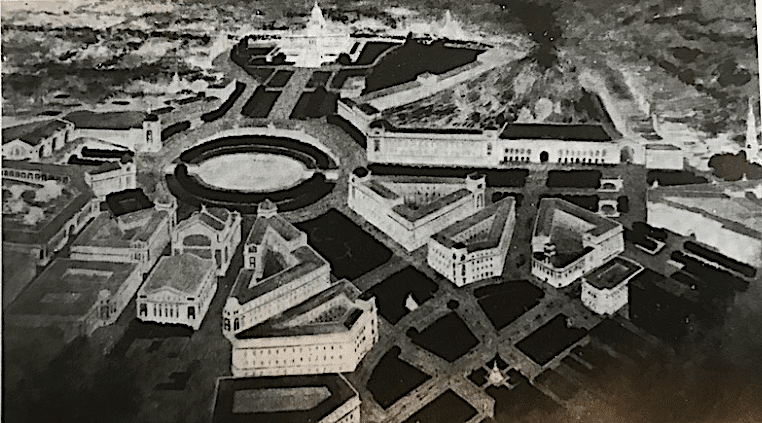Search Posts
Recent Posts
- Outdoors in RI: 138th Arbor Day, Princess Kate and access to nature, Winnapaug Pond, Vets fish April 18, 2025
- Saving lives, Paul Rego donates his 100th gallon of blood at the Rhode Island Blood Center April 18, 2025
- Rhode Island Weather for April 18, 2025 – Jack Donnelly April 18, 2025
- National Financial Literacy Month. BankRI offers free, virtual workshop: “Smart money moves… April 18, 2025
- GriefSpeak. Technology in Death and Grief – Mari Nardolillo Dias April 18, 2025
Categories
Subscribe!
Thanks for subscribing! Please check your email for further instructions.

RISD’s Huger Elliott (1910), on Providence – David Brussat
by David Brussat, Architecture Here and There, contributing writer
Photo: Illustration from 1910 for design competition of Cove Basin near new State House. (AIAri)
Architect Eric Daum recently passed along an illustration, above, done in 1910 by RISD president Huger Elliott. It expressed how the area of Providence between the new State House and downtown might look in 1950 if it were designed in a classical style. Architect Robert Orr then sent a 1915 article (scroll down to page 23, “Architecturl Unity”) in the Board of Trade Journal about how Elliott believed the city should be developed so as to strengthen its historical character. The anonymous author quotes Elliott as follows:
… [T]he people of Providence ought to cultivate the feeling that architecture of uniform classic or Colonial type should be developed all over the city. The greater the uniformity up to a certain point, the more interesting the city will [be] as a whole.
I replied to my correspondents eagerly, happy to have found a co-conspirator who believed a century ago what I have maintained for 30 years in my Providence Journal columns and my blog. Even today the city’s zoning laws warn repeatedly that new development should maintain the city’s historical character. (This has been almost uniformly ignored.) After I left the Journal in 2014, I wrote a book called Lost Providence that included Elliott’s illustration on page 108. It was drawn as part of a design competition sponsored by the Rhode Island chapter of the American Institute of Architects.
So all this was causing me to pulsate with joy, as longtime readers can imagine. But then I read the next sentence in the article from the trade journal:
If we could insist that all our architecture should be harmonious, even to the extent of tearing down some of our present buildings and reconstructing them for this purpose, it should be a distinct advance and would make Providence unique among American cities.
Well, “tearing down some of our present buildings” might work fine today, but in 1915 it would have been a disaster. Imagine demolishing the John Carter Brown Library on the Brown University main green, a Beaux Arts masterpiece completed in 1904, in favor of a new colonial, however elegant. I don’t think so. By 1915, when the piece on Elliott’s ideas was penned, many buildings in downtown Providence were of styles that were not Colonial. If Elliott were in charge, we might have lost many of those fine buildings.
So of course I had to reply to my correspondents “somewhat retracting” my enthusiasm for Huger Elliott.
The people who populate the committees overseeing design in Providence seem not to want to advocate development that strengthens the historical character of the city, its so-called “brand.” Instead, they want Providence to, as the author of the Elliott article put it, “resemble the rest of the world” rather than “asserting its own individuality or ‘local color.’ ”
It is said that design and architectural schools’ first job is to purge students of their instinct for beauty. This would explain most of the actions of design committees, in Providence and elsewhere. It is equally true that such schools purge students of all their senses and much of their intelligence. The desirability of maintaining some sort of aesthetic cohesion in the development of a city seems obvious, but not to most who are involved in such important projects.
Think of the celebrated Providence mystery writer H.P. Lovecraft, who used to stroll (or one might say “haunt”) the streets of the city after dark, and who wrote extensively in letters to friends about its old architecture, and planned but never executed a book on the subject. He, too, preferred the city’s historic Colonial houses and buildings. He wrote a long letter to the editor of the Journal in the 1920s expressing his approval of the neo-Georgian courthouse being proposed on South Main Street. He also regretted the associated plan to level the “Brick Row” of warehouses from the 1840s, even though he probably would have liked the courthouse annex that was supposed to replace them, but never did. It was used as parking for six decades, and is now a park with the World War I memorial at its center. He actually used to regret the erection of what today we would consider fine old classical buildings, which he called “modern.” Imagine how horrified Lovecraft would be today!
I have long envied the heated design debates of long ago, before modernism, when architects disputed the merits of Gothic or Classical styles. How minor the battle of styles was then, even though it seemed vital to those who argued either side. Little did those embattled critics know what was to come in decades not long after.
Well, nevertheless, it was nice to get a brief thrill from a man who led the Rhode Island School of Design back in the day when it knew what it was about.
_____
To read other articles by David Brussat: https://rinewstoday.com/david-brussat-contributing-writer/

My freelance writing and editing on architecture and others addresses issues of design and culture locally and globally. I am a member of the board of the New England chapter of the Institute of Classical Architecture & Art, which bestowed an Arthur Ross Award on me in 2002. I work from Providence, R.I., where I live with my wife Victoria, my son Billy and our cat Gato. If you would like to employ my writing and editing to improve your work, please email me at my consultancy, [email protected], or call (401) 351-0457

